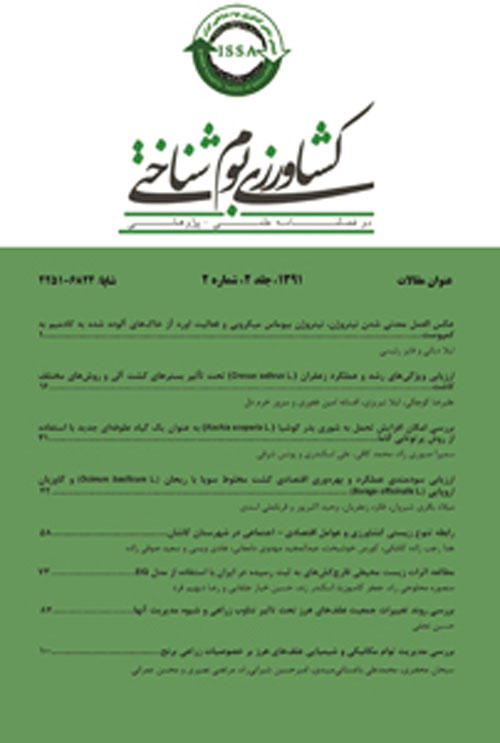Comparison of energy use efficiency and economic analysis in melon and cotton production system of Torbat-e-Jam
Author(s):
Abstract:
Introduction
Energy use efficiency in agricultural systems needs to be improved to reduce dependency on nonrenewable energy sources (Erdal et al., 2007). Recognition of crop production methods that maximize energy efficiency and minimize application of energy inputs is essential (Ozkan et al., 2004b). The objectives of this study were to compare melon and cotton production systems in terms of energy use efficiency, energy intensiveness, energy productivity, benefit-to-cost ratio, renewable and non-renewable energy consumption in Torbat-e-Jam city in Khorasan-Razavi province.Materials And Methods
Data were collected by using a face-to-face questionnaire from 104 and 75 melon and cotton farms, respectively, during 2011. Energy inputs included chemical fertilizers, diesel fuel, pesticides, seed, machinery and human labour (Ozkan et al., 2004a). Energy indices (energy use efficiency, energy productivity, specific energy and net energy) were computed for melon and cotton production systems. All inputs consumed in crop production were classified into direct and indirect, renewable and non-renewable sources. Input-output analysis was also used to determine economic criteria including gross return, gross value of production, net return, total cost of production, benefit-to-cost ratio and productivity.Results And Discussion
The results revealed that energy consumed in melon and cotton production was 135382.5 and 98494.5 MJ ha−1, respectively. Among the energy inputs, electricity (45.4% and 59.0%, respectively for melon and cotton), irrigation water and chemical fertilizers contained the highest energy shares for melon and cotton farms in the region. About 71% of the total energy inputs used in melon production system was indirect and 29% was direct; while the share of direct and indirect energy for cotton production was 79%and 21% respectively. Results further indicated that 80% and 82% of total energy input for melon and cotton, respectively, was in non renewable energy, and only 20% and 18% was in renewable. Mean melon (fresh weight) and cotton (boll) yield was about 15767 and 3579 kg ha-1, and energy use efficiency was 0.22 and 0.44, respectively. Economic analysis indicated that total cost of melon and cotton production was 2468 and 1681 US Dollars per ha-1, respectively. The benefit to cost ratios were calculated as 1.63 and 0.57 in melon production system and 3.19 and 0.20 in cotton production system.Conclusion
Low energy productivity in melon and cotton production systems indicated an intensive use of inputs not accompanied by increase in the final product. Consideration should be given to employing new electrical pumps to water pumping, increasing water use efficiency, introducing and implementing reduced (conservation) tillage and decreasing consumption of diesel fuel in order to decrease the amount of non renewable energy use in the region studied. This will lead to lower levels of water and soil pollution and will make the crop production environment friendly. Keywords:
Language:
Persian
Published:
Journal of Agroecology, Volume:6 Issue: 2, 2017
Page:
29
magiran.com/p1680989
دانلود و مطالعه متن این مقاله با یکی از روشهای زیر امکان پذیر است:
اشتراک شخصی
با عضویت و پرداخت آنلاین حق اشتراک یکساله به مبلغ 1,390,000ريال میتوانید 70 عنوان مطلب دانلود کنید!
اشتراک سازمانی
به کتابخانه دانشگاه یا محل کار خود پیشنهاد کنید تا اشتراک سازمانی این پایگاه را برای دسترسی نامحدود همه کاربران به متن مطالب تهیه نمایند!
توجه!
- حق عضویت دریافتی صرف حمایت از نشریات عضو و نگهداری، تکمیل و توسعه مگیران میشود.
- پرداخت حق اشتراک و دانلود مقالات اجازه بازنشر آن در سایر رسانههای چاپی و دیجیتال را به کاربر نمیدهد.
In order to view content subscription is required
Personal subscription
Subscribe magiran.com for 70 € euros via PayPal and download 70 articles during a year.
Organization subscription
Please contact us to subscribe your university or library for unlimited access!


